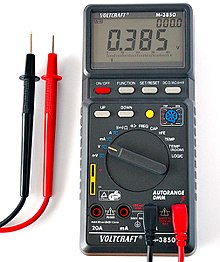Multimeter
A multimeter (from Latin multus "a lot" and ancient Greek μέτρον métron "tool for measuring"), also called a multiple measuring device , is an electrotechnical measuring device that can be used for several measured variables and in several measuring ranges .
The basic equipment of a multimeter includes its usability as a voltage measuring device and current measuring device . As a rule, it can also be switched between measurements of constant and alternating quantities. It is also common equipment as resistance meter . In some cases one or the other additional function is available.
A distinction is primarily made between digital and analog multimeters. Purely analog multimeters have played an increasingly minor role in practical measurement technology since the 1990s and are increasingly being replaced by digital multimeters for reasons of price. In addition to the oscilloscope , the multimeter is one of the most important measuring and diagnostic tools in electronics and electrical engineering . Because of its comparatively low purchase price and the wide range of applications, it is also widely used by electronics hobbyists and do-it-yourselfers .
In addition to devices that can be held in the hand, there are also portable, mains-operated table multimeters and system devices that are often used in automatic test systems.
Digital multimeter
With digital multimeters, the signal is recorded electronically with an analog-digital converter and the measured value is displayed as a numerical value. The measuring ranges usually extend from 200 mV to 1000 V and from 20 µA to 20 A. When measuring voltage, digital multimeters usually have a high internal resistance of 1 to 20 MΩ, the standard is 10 MΩ. The relative error limit is usually less than 1%, depending on the measuring range, in the DC voltage ranges it is usually less than 0.2% for higher quality devices.
The measurement of current is carried out by measuring the voltage on switchable shunt resistors . The measurement of resistance is traced back to the measurement of voltage based on a switchable constant current source .
Advantages of digital multimeters are the relatively simple mechanical structure and electronic components that can be mass-produced, which means that they are available relatively inexpensively, usually cheaper than a good analog device. Operation is very easy because the units of measurement are shown in the display and by avoiding multiple scales. Furthermore, some digital devices have protective circuits against overload and polarity reversal. Convenient devices can automatically select the voltage measuring range (auto range function). They are relatively insensitive to impacts and falls, as no sensitive mechanics can be damaged.
Due to the internal electronics for signal processing and display on the display, digital multimeters are always dependent on a supply from a battery , power supply unit or solar cell .
Some devices also have measurement options for frequencies , capacitances , inductances, and transistor and diode properties . Using built-in or external sensors , some devices can also measure humidity , sound or temperature . An acoustic continuity tester is also built into almost all digital devices.
Analog multimeters
With analog multimeters, the measured value is displayed on a pointer measuring device with several scales for different measuring ranges. The readings are represented by discrete tick marks, intermediate values can be interpolated . The error limits of analog measuring devices can be less than one percent of the full scale value for high-quality devices . A moving-coil measuring mechanism is usually used as the decisive component that provides the display .
The measuring ranges of moving coil devices extend for example for DC voltages from 100 mV to 1000 V, for DC currents from 100 µA to 10 A, high quality devices sometimes have even smaller ranges. When measuring voltages, analog multimeters generally have a significantly lower internal resistance than digital multimeters, which can lead to measurement deviations ( circuit influence ) with high-resistance voltage sources . The influence of the internal resistance when measuring current and voltage can be reduced by built-in amplifiers , whereby such analog multimeters achieve a high internal resistance when measuring voltage , which can correspond to that of digital multimeters.
To measure the resistance, the current is measured that a built-in battery allows to flow through the resistor. The relationship is strongly non-linear; the measurement is only suitable for making rough statements. Amplifier electronics for scale linearization can also be used for resistance measurement in very high-quality devices.
Web links
Individual evidence
- ↑ Erich Pertsch: Langenscheidts Large School Dictionary Latin-German . Langenscheidt, Berlin 1978, ISBN 3-468-07201-5 .
- ^ Wilhelm Gemoll : Greek-German school and hand dictionary . G. Freytag Verlag / Hölder-Pichler-Tempsky, Munich / Vienna 1965.

